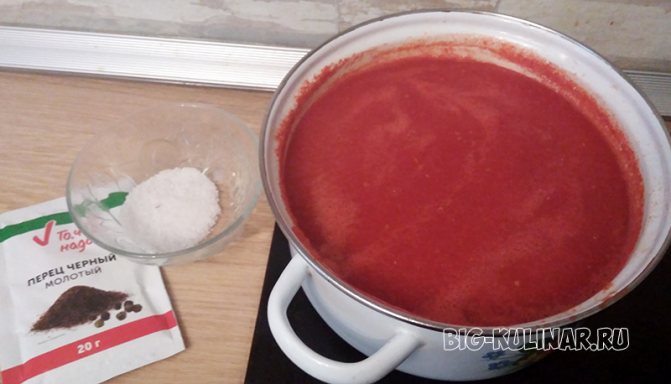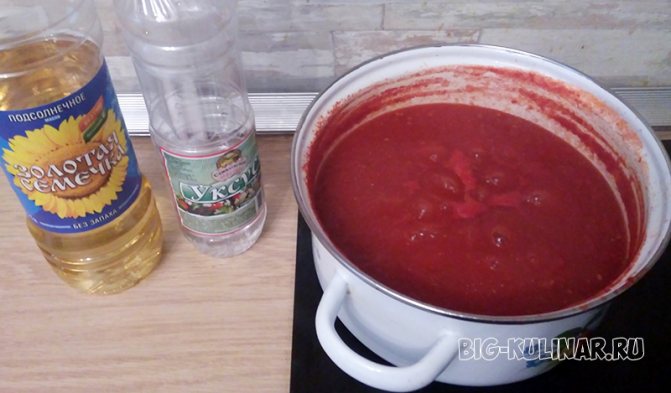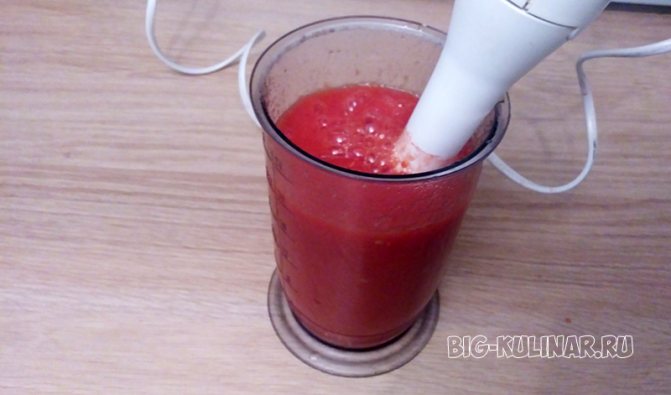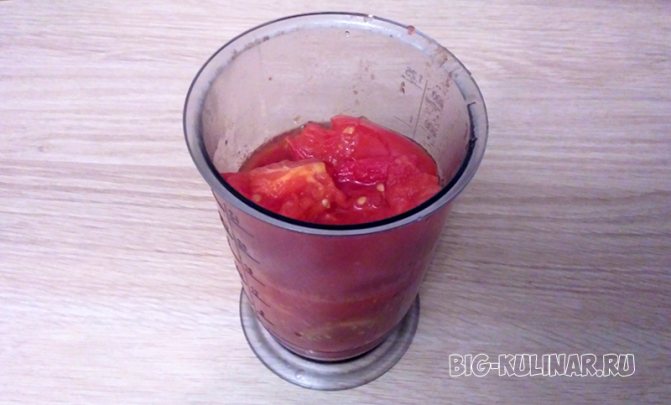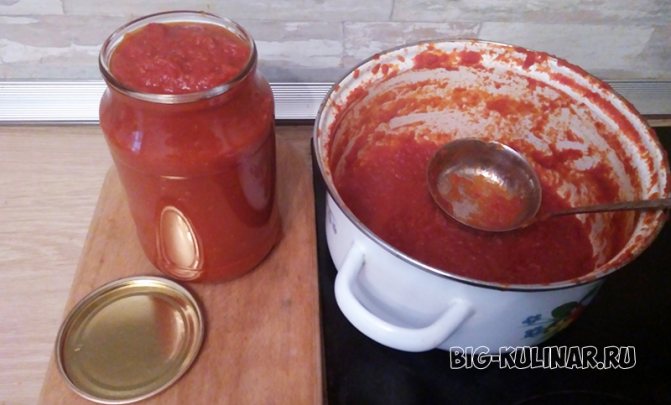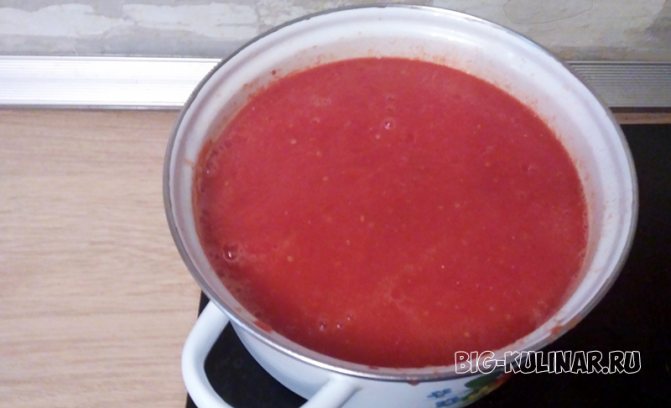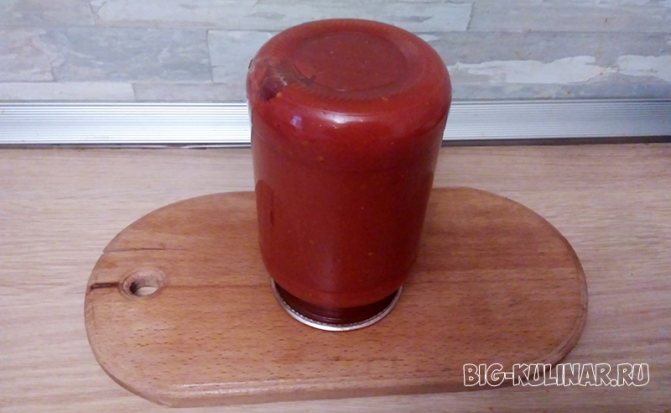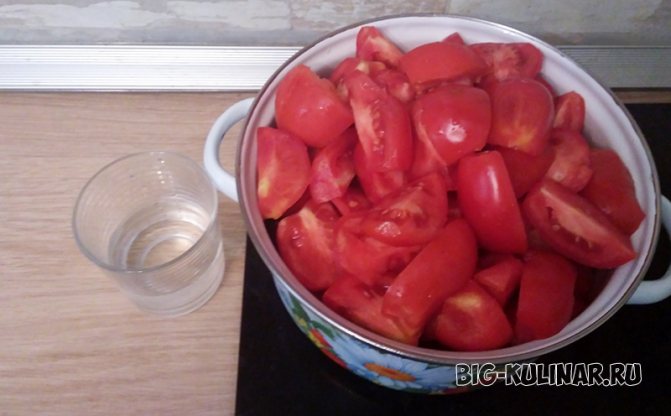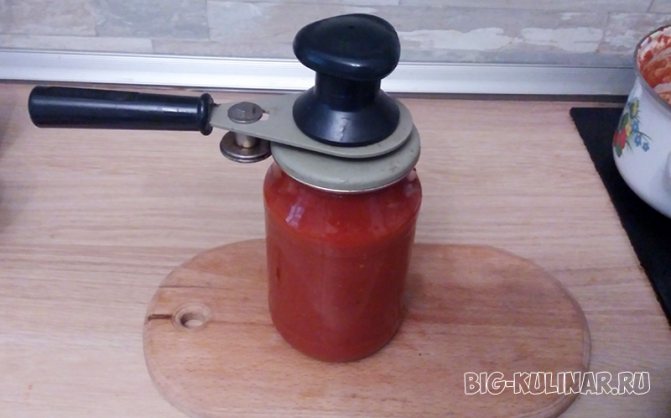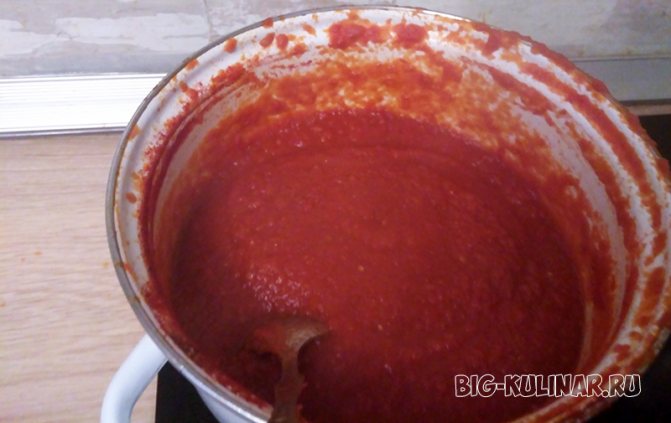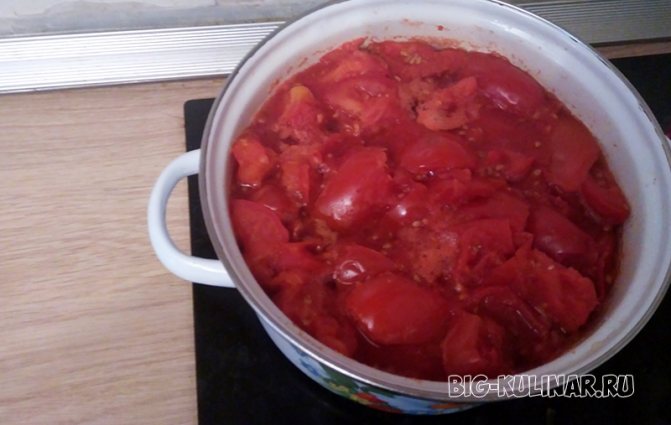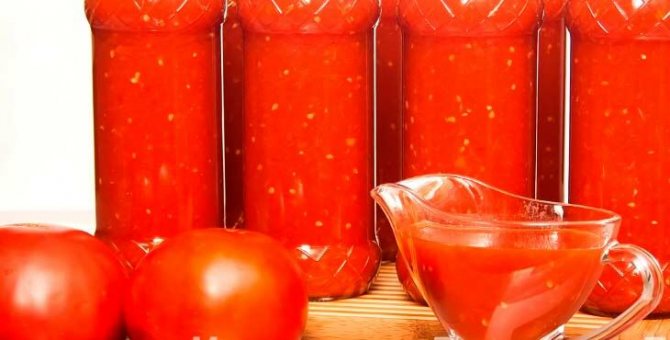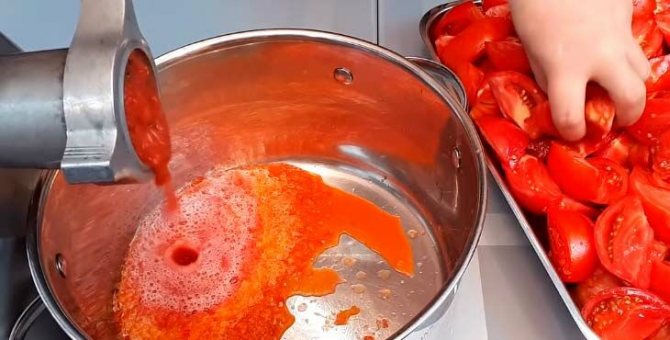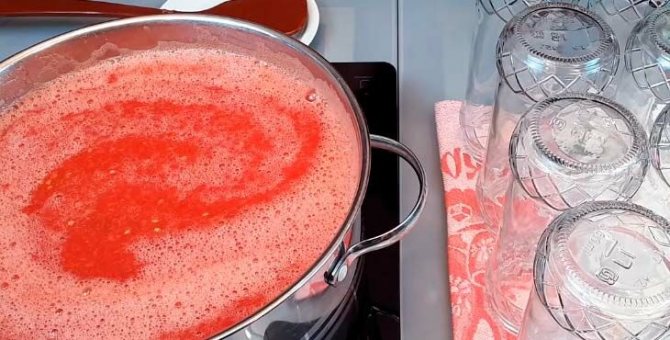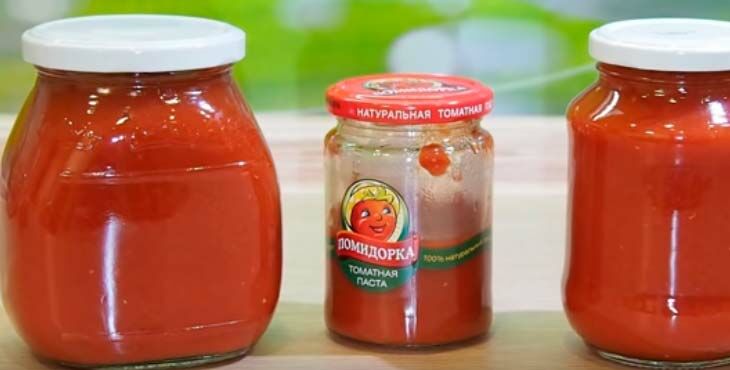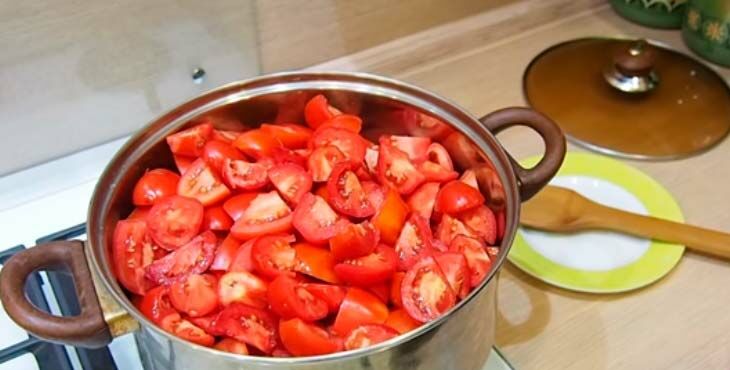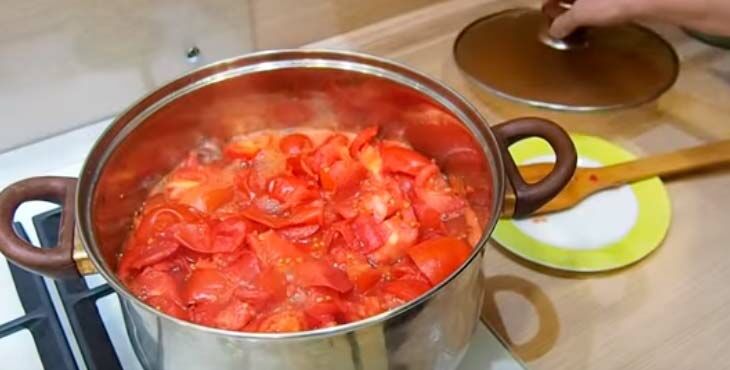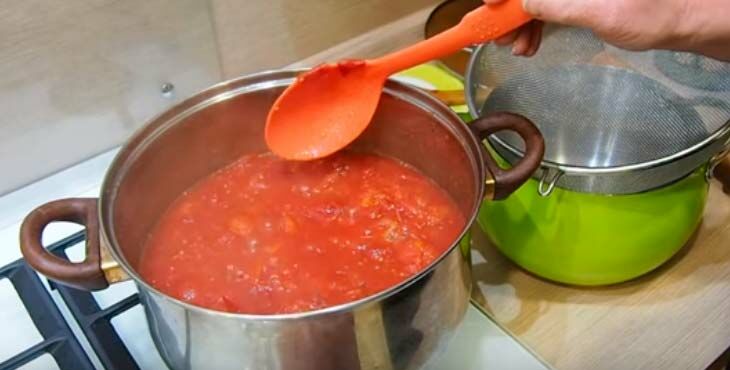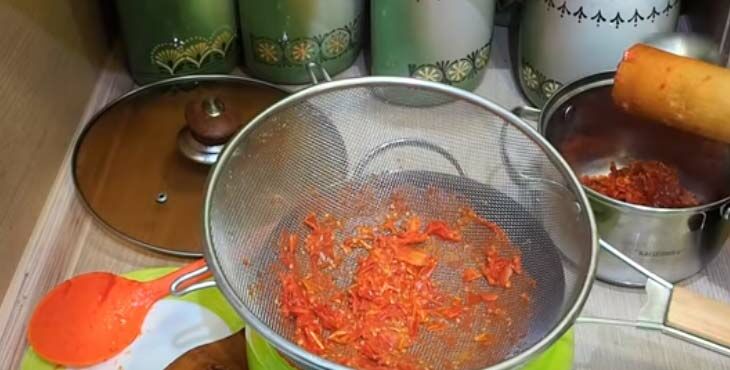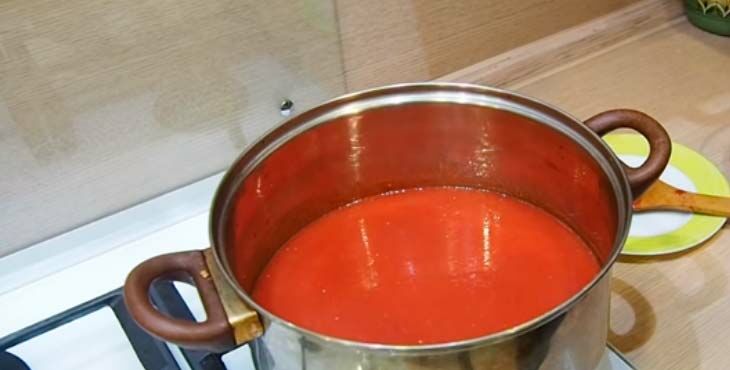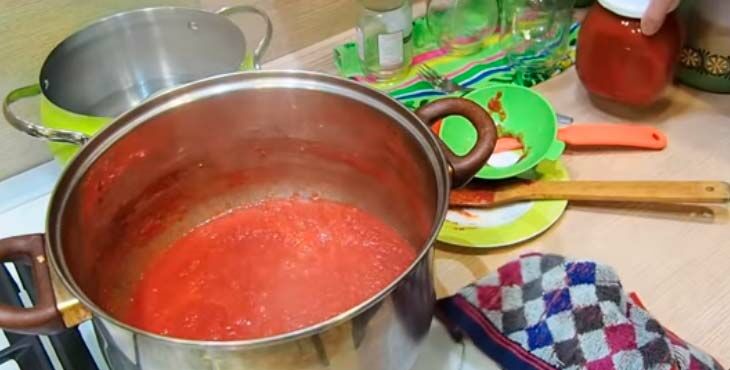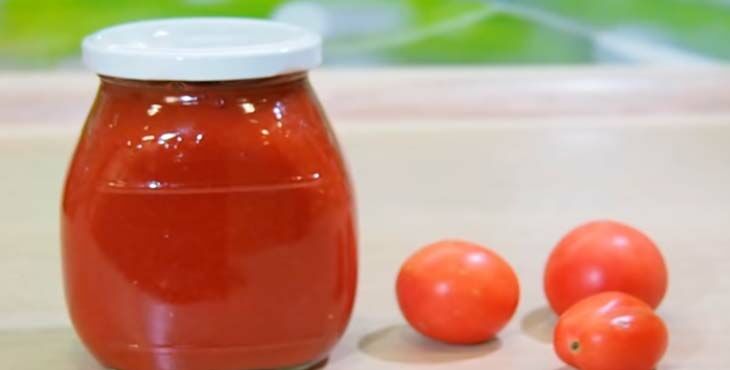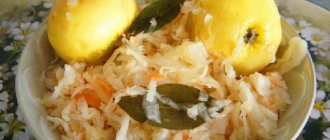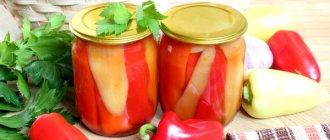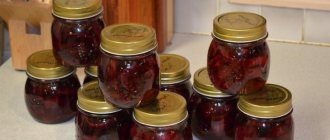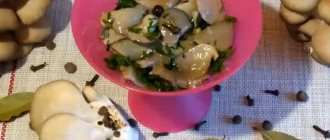It used to be like this - you rolled tomatoes into jars, but there were those that did not get into them. Where is the speck, where is the dent, where is the damage. It seems that they are not particularly suitable for fresh salads. In such cases, I make tomato paste. It turns out to be quite thick, which significantly reduces the number of cans. In addition, it can be frozen. It keeps well frozen. But for borscht and various gravies just right. Add two or three tablespoons and you get deliciousness.
This dressing is prepared in different ways. Scroll vegetables in a meat grinder, chop in a blender, cook on the stove or in a slow cooker. Yes, and a bunch of recipes. For example, my mother added both carrots and bell peppers to it. Someone puts greens, onions or garlic. This option is not suitable for me. I still think that carrots and peppers can be put in a dish raw. And the pasta should still consist of only tomatoes with a little salt.
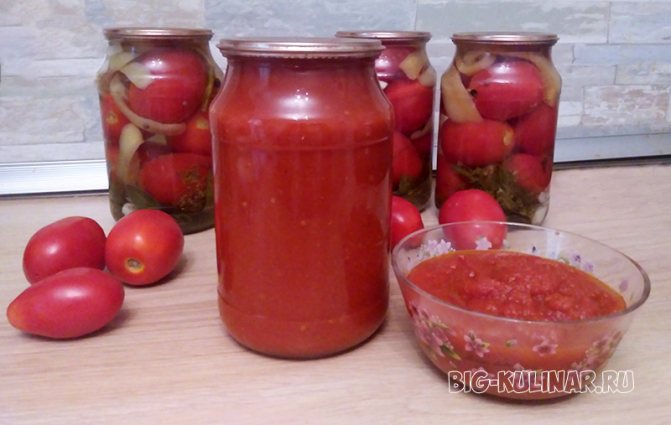
There is nothing complicated in the preparation of this miracle blank. This process consists of two stages - chopping the fruits and boiling them. I'll tell you how I do it.
The principles of cooking tomatoes in tomato sauce
When preserving tomatoes in tomato sauce, instead of the classic marinade, juice, fresh tomato sauce or canned tomato paste are used. Such a blank is universal, it uses completely fruits and sauce.
> Selecting and preparing tomatoes
Fresh, firm, medium-sized fruits are selected for harvesting. To prepare the sauce, tomatoes of any size and shape are suitable, the main thing is without rot and spoilage.
> How to prepare a container?
After thorough washing, glass containers are sterilized in the usual way. You can fry in the oven, steam over boiling water, use the microwave.
Procurement methods
It is possible to harvest tomatoes in filling in cans with a volume of one to three liters, with or without sterilization, but covering the preservation with something warm until it cools.
Classic recipe
Harvesting according to the classic recipe does not contain additional seasonings and spices, which is why the fruits retain their fresh taste.
Structure:
- 700 grams of small, dense tomatoes;
- 100 grams of tomato paste;
- dessert spoon of salt;
- the same amount of sugar;
- 20 milliliters of vinegar.
Put the fruits in a container. For pouring into tomato paste, pour 1.5 cups of water. The juice is mixed with salt and sugar, boiled for 8 minutes, vinegar is poured. Pour the tomatoes with sauce, close hermetically, wrap.
Fast way without sterilization
The tomatoes preserved according to this recipe are delicious, aromatic, and cook quickly.
Required products:
- 1.5 kilograms of tomato;
- 300 grams of tomato paste;
- 1.5 tablespoons of salt;
- 2 faceted glasses of sugar;
- 3 peas of different peppers;
- 2 laurel leaves.
Fruits in jars are poured with boiling water, heated for 8 minutes. Put the rest of the ingredients in the drained liquid, cook for 3 minutes. Pour vegetables with sauce, twist, cover until morning.
No vinegar
Pickled tomatoes without skin are harvested.
Structure:
- 2.5 kilograms of tomato;
- 200 grams of tomato paste;
- 1.5 liters of water;
- 30 grams of salt;
- 25 grams of sugar.
Free the fruit from the skin. Mix the paste with water, add salt and sugar, let it boil. After that, the peeled tomatoes are lowered for 30 seconds, transferred to a sterile container, and poured with sauce. The sealed canned food is covered with a blanket for a day.
With dill and cloves
The preparation perfectly combines dill with cloves and bay leaves.
The following products are taken for seaming:
- 7 kilograms of tomato;
- liter of tomato paste;
- a couple of dill bushes with seeds;
- 9 carnation buds;
- laurel leaf;
- a glass of sugar;
- 1.5 glasses of salt.
You can twist the tomatoes using the classic recipe. In the cooking process, spices are added when cooking the sauce. Dill is placed along with tomatoes.
With gelatin
The blank will surprise with its taste and will complement the festive table.
The following products are required:
- a kilogram of small tomatoes;
- 60 grams of tomato paste;
- 0.5 glasses of sugar, salt;
- a bag of gelatin;
- a third of a glass of vinegar;
- liter of filtered water.
A little water is poured into the gelatin, kept for 10 minutes to swell. The fruits are put in a container.
Diluted paste, salt, sugar, vinegar are gradually introduced into gelatin, heated, but not boiled. Fruits are poured with sauce, sterilized for 10 minutes. Clogging up.
Spicy tomatoes in tomato sauce
Hot sauce is used in the preparation of first courses.
Components:
- 4 kilograms of dense tomatoes;
- 1.5 liters of tomato paste;
- 4.5 liters of purified water;
- 3 hot pepper pods;
- Bay leaf;
- 90 grams of coarse salt;
- 30 grams of sugar;
- 25 milliliters of vinegar.
Diluted tomato is salted, sugar, finely chopped pepper, bay leaf are added. Boil the sauce for 7 minutes, pour in vinegar, cook for a couple of minutes.
The fruits are distributed in jars, poured with water for seven minutes. After the liquid is poured out, the jar is filled with boiling sauce. Seal. The blockage is wrapped in a blanket. A day later, they are removed for storage.
With currant leaves
A classic recipe is used for canning. When cooking the sauce, a few currant leaves are added. Pouring the prepared sauce into the jars, you must remove the currant leaves.
With cinnamon and cloves
Tomatoes are peeled. Half a cinnamon stick, 5 cloves buds, 3 allspice peas are placed in a bag made of gauze.
The paste is diluted in one liter of water, salt, sugar are added, a gauze bag is immersed. The filling is prepared for 15 minutes. After the spices are removed, the tomatoes are poured with a spicy sauce. Seal. The curl should be under a warm blanket until it cools completely.
Sweet tomatoes in tomato paste
This recipe will appeal to lovers of very sweet tomatoes.
You will need the following ingredients:
- 2 kilograms of tomato;
- 4 cloves of young garlic;
- dessert spoon of salt;
- a glass of sugar;
- 200 grams of tomato paste;
- 1.5 liters of spring water.
Fruits with whole chives are placed in a container, boiling water is poured. The paste is mixed with water, sugar and salt are added. Cook for 3 minutes. The liquid is drained, the pouring is poured into the heated fruits. Seal.
With celery
To cook tomatoes with celery, you need to use the recipe for sweet tomatoes with tomato paste. In the process of cooking, a bunch of celery is placed in the sauce, which is then removed.
With green tomatoes
The workpiece can be made not spicy by replacing hot peppers with Bulgarian ones.
Required products:
- a kilogram of small green tomatoes;
- 500 milliliters of filtered water;
- 90 grams of tomato paste;
- 2 pieces of hot pepper;
- a teaspoon of salt;
- a third of a glass of sugar;
- 4 cloves of garlic;
- 15 grams of vinegar.
Tomatoes are cut in half, put in a cooking bowl. Pour in a paste diluted with water, salt, add sugar. Chopped garlic with pepper is added. The appetizer is prepared for 12 minutes. Pour vinegar, let it boil. The workpiece is distributed among the banks. Clogging up.
With garlic
The blank is made without sterilization.
Ingredients:
- a kilogram of tomatoes;
- head of garlic;
- 150 grams of tomato paste;
- a third of a glass of coarse salt;
- a third of a glass of sugar;
- 2 laurel leaves.
Cook according to the recipe “Sweet tomatoes in tomato paste”.
With horseradish and bell pepper
The workpiece is sharp, with a long shelf life.
Required components:
- 1.5 kilograms of dense tomatoes;
- 500 grams of tomato paste;
- 150 grams of carrots, bell peppers;
- 100 grams of grated horseradish;
- a small bunch of parsley;
- 100 grams of garlic;
- 60 grams of non-iodized salt;
- 150 grams of caster sugar.
Parsley and tomatoes are placed in a jar. Vegetables are poured with boiling water for fifteen minutes. The drained liquid is replaced with sauce.
Lettuce pepper, horseradish, carrots with garlic are passed through a meat grinder. Tomato is diluted with a glass of water, mixed with vegetable gruel. Pour in salt and sugar, cook for ten minutes, removing the foam. Spicy tomatoes are screwed tightly.
Tomatoes stuffed with garlic and herbs, drenched in tomato juice
For spiciness, hot pepper can be added to the filling.
You will need:
- a kilogram of tomatoes;
- liter of tomato juice;
- head of young garlic;
- a bunch of parsley;
- a quarter glass of vinegar;
- 150 grams of caster sugar;
- 30 grams of salt;
- laurel leaf;
- 3 allspice peas.
The fruits are cut to the stem. Finely chopped greens with garlic are placed in the middle of the tomatoes, placed in a glass container.
Prepare the tomato juice with the remaining ingredients for 8 minutes. The sauce is poured into a container with tomatoes. Add 2 tablespoons of hot vegetable oil to the jar. Cover with a lid. The workpiece is sterilized for 17 minutes. Clogging up.
Cherry tomatoes in their own juice with pasta
Pickled cherry tomatoes are not only delicious, but also serve as an excellent decoration for the festive table.
Required products:
- a kilogram of cherry tomato;
- 500 milliliters of filtered water;
- 120 grams of tomato paste;
- 75 grams of granulated sugar;
- incomplete dessert spoon of salt;
- dessert spoon of vinegar.
Cherry is placed in a glass container, poured with boiling water. Tomato is diluted with purified water, salt and sugar are added. After boiling, add vinegar. The filling is prepared for half a minute.
Warm liquid is drained from a jar of vegetables, filled with tomato filling. The preservation is screwed tightly. Wrap up with a warm blanket.
Tomatoes stuffed with garlic and herbs, drenched in tomato juice
Tomatoes for this recipe must be of particularly dense varieties, preferably hollow, ideally suited for stuffing.
Comment! The so-called hollow tomato varieties include Bulgaria, Yellow Staffer, Starlight Staffer, Green Bell Pepper, Meshchanskaya filling, Figurny.
You will need:
- 1 kg of tomatoes for stuffing;
- 1 kg of ordinary tomatoes for juice or 1 liter of ready-made drink;
- 200 g onions;
- 1 head of garlic;
- 150 g carrots;
- 25 g of parsley root and 10 g of its greens;
- 1.5 tbsp. spoons of 9% vinegar;
- 2 tbsp. tablespoons of sugar;
- 1 tbsp. a spoonful of salt;
- allspice and lavrushka to taste;
- vegetable oil (for frying and for pouring)
This delicacy dish is made as follows.
- Juice is cooked from soft tomatoes or sugar, salt, spices, vinegar are added to the finished product and they are boiled for 8-10 minutes.
- Roots of parsley and carrots, as well as onions are finely chopped and fried until the color of creamy ice cream.
- Then they are mixed with chopped garlic and parsley and heated to 70 ° -80 ° C.
- Hollow tomatoes up to half about the stalk, if necessary, remove the seeds and fill with a filling of herbs and vegetables.
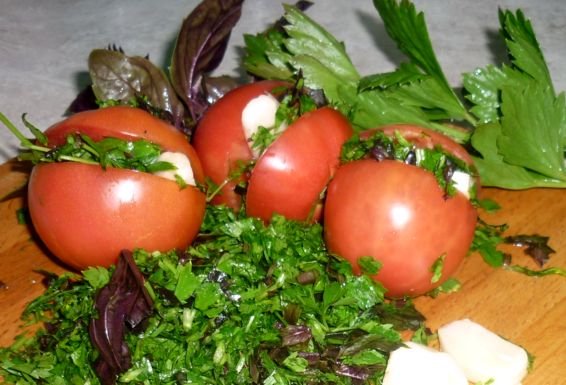

- Stuffed tomatoes are tightly laid out in jars and poured with hot juice with spices.
- Vegetable oil boiled in a separate container is poured on top, hoping that 2 tablespoons of oil should go to 1 liter of filling.
- Banks are sterilized in boiling water for about 30 minutes (liter).
Terms and rules for storage of blanks
Canned tomatoes can be stored in a cool, dark room, pantry, on the bottom shelf of your refrigerator, or in your basement. Preservation should not be in a bright room, where direct sunlight penetrates.
The shelf life of a vegetable preparation at room temperature is no more than twelve months.Tomatoes, which are at a temperature of no higher than five degrees, are stored for three years.
We sort out the tomatoes, put them aside with cracks, crumpled, with spots. Rinse dense ripe tomatoes thoroughly with running water.
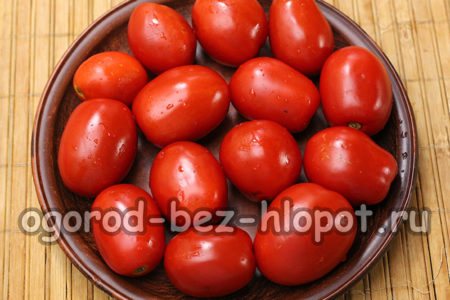

In a liter jar, put two or three sprigs of parsley or celery, bay leaf, a ring of hot paprika, peppercorns and garlic, as in the photo.
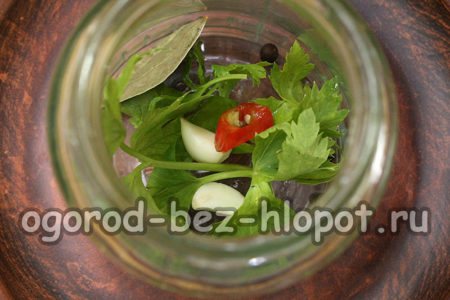

We fill the jar with prepared tomatoes, placing the larger ones on the bottom. Shaking the jar, fill it to the brim, filling the empty spaces with greens. Pour boiling water for ten minutes, then pour out this water. If you cook with sterilization, you do not need to pour boiling water over the tomatoes.
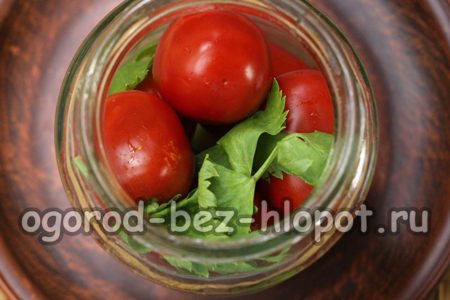

In a ladle or a small saucepan, boil water for the second pouring, add tomato paste. Dissolve, if foam rises when boiling, collect it with a spoon.
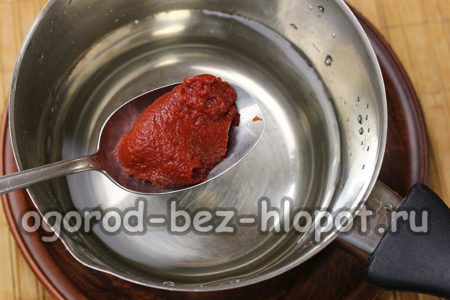

Let the filling boil for a few minutes, add salt and sugar. We boil for a couple of minutes.


Pour in vinegar. For a liter of pouring, a tablespoon of vinegar of 9% concentration is needed. Turn off the fire.


Before pouring the filling into the jars, stir it so that no sediment remains at the bottom. Pour into jars to the very edge. We tighten hermetically or set to sterilize for 15 minutes (in this case, we do not roll up the jars, you need to seal them with lids after sterilization).
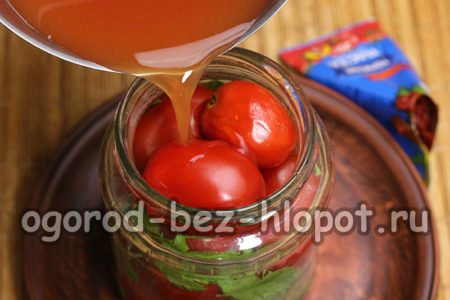

Cool the finished tomatoes by wrapping them in a blanket or towel, then store them in the basement or put them in the pantry. Good luck with your blanks!
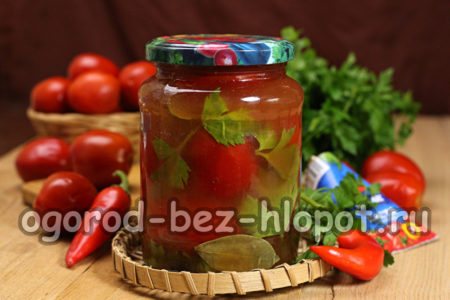

Cooking tips
The main advantage of homemade pasta is its naturalness. Unlike a similar product bought in a store, homemade tomato paste does not contain taste stabilizers, thickeners or harmful preservatives. You can be sure of its quality and usefulness, because in addition to taste, the product includes sodium, magnesium, iodine, sulfur, vitamins of almost all groups and other trace elements.
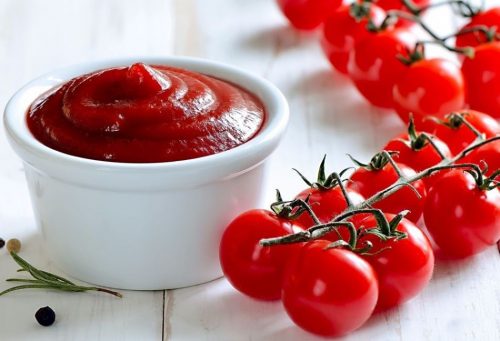

Before making tomato paste, you must adhere to the following rules:
The use of meaty varieties
In such varieties, the pulp is well boiled, and the skin is easy to separate. Meaty varieties include Bull Heart, Pink Honey, Pinky Lady, Mikado, Pink Rise. Almost all meaty tomatoes are grown in the greenhouse;
Ripe fruits
The most ideal option for cooking is to use overripe fruits. They have a beautiful color and rich taste;
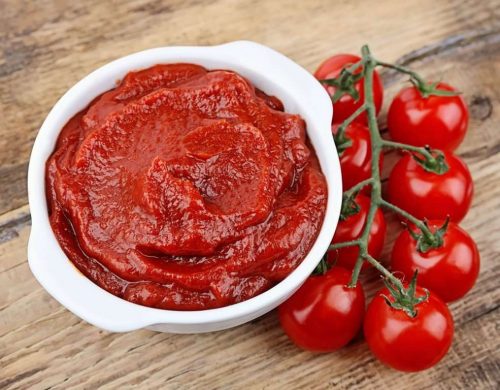

Volume and preparation of containers
The cleanliness of the container has the greatest influence on the shelf life of the finished product. For storage of workpieces, glass jars with lids are used. You do not need to use large-volume cans, containers of 0.2, 0.5 liters are quite suitable. It is convenient to store such a jar in the refrigerator, and its contents will quickly be used up and will not stale. It is advisable to sterilize the jars in the oven or steamed for disinfection before cooking. However, there are preservation methods that exclude sterilization;
Use of spices
In addition to salt and pepper, you can put rosemary and red pepper, paprika, dried garlic, basil, a mixture of Italian spices in the blank;
Proper storage
The finished product is stored at a low temperature of 10-16 degrees Celsius. You can store jars in your basement or refrigerator. Homemade tomato paste has a shelf life of one year. An open can is stored in the refrigerator for up to one month.
Recipe for rolling tomatoes in tomato sauce
Kitchen utensils: sterilized 3-liter jar, sterilized iron lid, kitchen scales and measuring utensils, a saucepan of at least 3 liters, a wooden long spoon, a lid-rolling machine, a warm blanket.
| granulated sugar | 15-20 g |
| salt | 45-50 g |
| water | 2-2.5 l |
| medium sized tomatoes | 2-2.5 kg |
| black peppercorns | 9-11 pcs. |
| Bay leaf | 2 pcs. |
| tomato juice | 1-1.5 l |
| vinegar 9% | 10-12 ml |
Step by step cooking
- Thoroughly wash 2-2.5 kg of tomatoes, then lay them out on a towel so that they are completely dry.
- We sort the fruits by size and put them in a jar on top of the spices. Do not tamp them too much, as they can wrinkle.
- Pour 2-2.5 liters of clean water into a saucepan and bring it to a boil.
- Gently fill the jar of tomatoes with boiling water to the very neck, while pouring water in the center, and not on the walls of the container.
- We cover the jar with a lid and leave in this form to infuse and cool for 10 minutes.
- Pour 1-1.5 liters of tomato juice into a saucepan and put on medium heat.
- When the liquid starts to boil, reduce the heat to low and add 15-20 g of sugar, 45-50 g of salt.
- Stir everything well and add 9-11 pieces of black peppercorns, as well as 2 bay leaves and 10-12 ml of vinegar.
- Simmer the sauce for 13-15 minutes, while periodically stir the mass and remove the resulting foam with a spoon.
- After 10 minutes, carefully drain the water from the cans, cover them with lids and wait for the sauce to cook.
- Fill the jar with hot sauce to the very neck.
- We cover the container with a lid and roll it up using a special machine designed for this. We turn the jar upside down and send it to a dark place.
- Thoroughly wrap the preservation with a warm blanket and leave it in this form until it cools completely.
- We send the cooled cans to a storage place for conservation.
Video recipe for preserving tomatoes in tomato sauce for the winter
The step-by-step process of preserving tomatoes in tomato sauce can be viewed in the video below.
Culinary recommendations
- Before starting preservation, it is necessary to prepare the jars. First of all, they must be thoroughly wiped with a stiff brush, rinsed in warm water with a little soda. Then rinse thoroughly with clean water and dry by turning the neck down. Before direct filling with vegetables, glass containers must be poured over with boiling water again.
- Iron lids should also be thoroughly washed with soda or soap, then put into boiling water for 20 minutes. It is advisable to carry out this procedure before directly rolling the cans.
- Tomatoes must be thoroughly rinsed in warm water, removing the slightest dust and dirt.
- You should not use tomatoes of different varieties for preservation. It is best to choose firm, medium ripeness fruits of the same size, preferably medium or small varieties.
- In order to prevent the fruits from cracking, they must be pierced with a thin needle or a toothpick in the area of the stalk.
- During conservation, you can safely add various spices in accordance with personal taste preferences: horseradish, parsley, bay leaf, tarragon, dill, black allspice, whole garlic cloves, pieces of hot red pepper, cherry and currant leaves.
- According to this recipe, you can preserve green tomatoes in tomato sauce for the winter. The fruits are distinguished by their extraordinary taste and will definitely keep their whole shape.
Cooking tomato paste for the winter without vinegar
If, in addition to tomatoes, you also harvested a large harvest of apples, then you can also use them to make tomato paste. With the addition of apples, it turns out with a rich taste and delicate texture. If you want winter preparation with sourness, add sour apples, sweeter - respectively sweet. And if you consider that it is prepared without vinegar, then this is just doubly good!
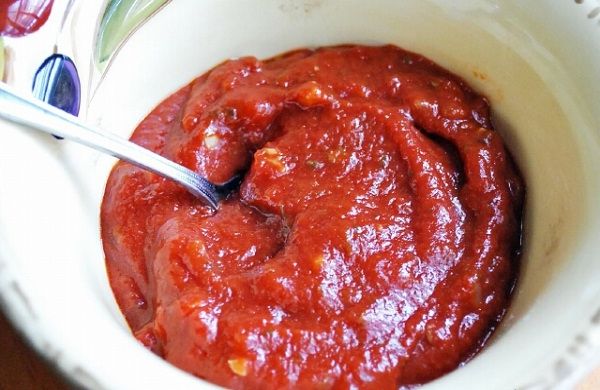

Ingredients:
- 4 kg of tomatoes;
- 1 kg of apples;
- ½ kg of onions;
- 3 tbsp Sahara;
- 3 tbsp salt;
- 20 black peppercorns;
- 8 bay leaves;
- 5 whole carnations;
- 1 tbsp red pepper;
- 1/2 tsp ground cinnamon.
Preparation:
1. For this recipe, select the ripe and meaty tomatoes. Grind them together with apples and onions in a meat grinder. Then the grated ingredients should be poured into the pan and mixed.
Do not cook in aluminum pans, as aluminum is oxidized and toxic substances can enter the food.
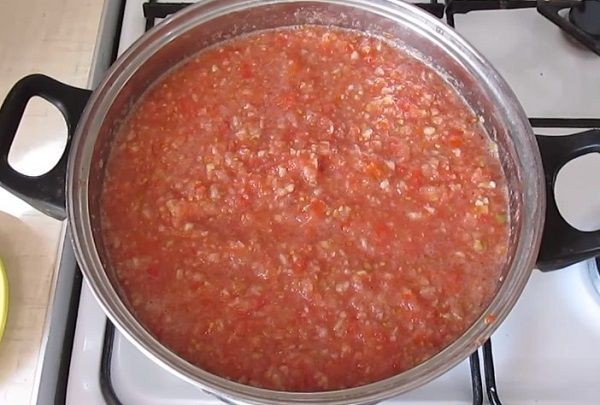

2. This mixture should be cooked over the fire for 1 hour, stirring occasionally.
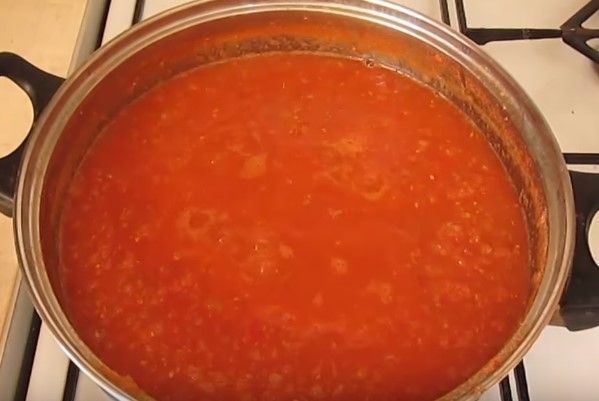

3. After an hour, add sugar and salt.You can vary their number to your liking. Stir well again and then add black pepper, bay leaf, cloves, red pepper and cinnamon.
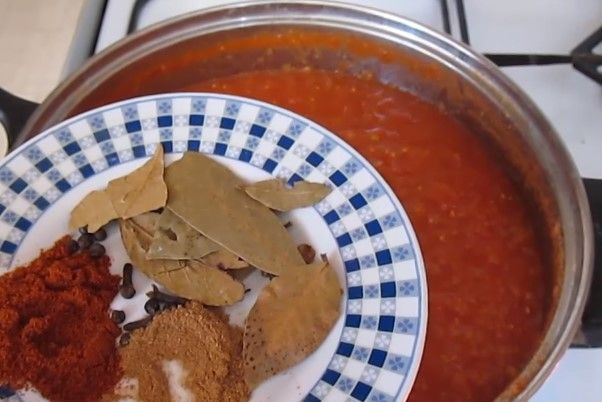

4. Then stir everything well again and continue simmering for about 3 hours. After this time has elapsed, the sauce will be ready.
5. The result should be about 3 liters of sauce. Therefore, we prepared 6 half liter jars, in each of which we added boiling water (half a jar) and closed with a lid. Due to the high temperature and steam, the jar together with the lid will be sterilized if left in this state for 10-15 minutes.
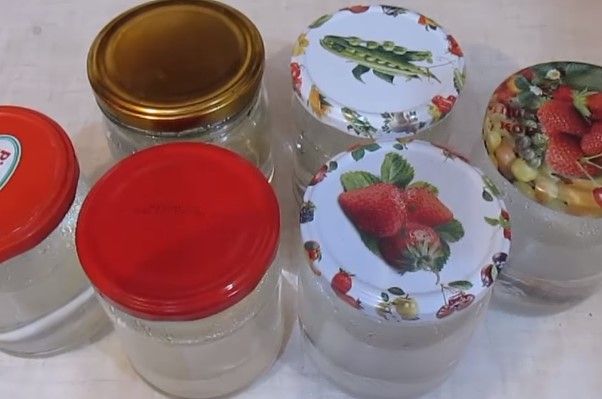

6. Then open the lids and pour out the boiling water. Then turn the cans upside down and place them on a towel to remove excess moisture. Pour the resulting sauce into the jars.
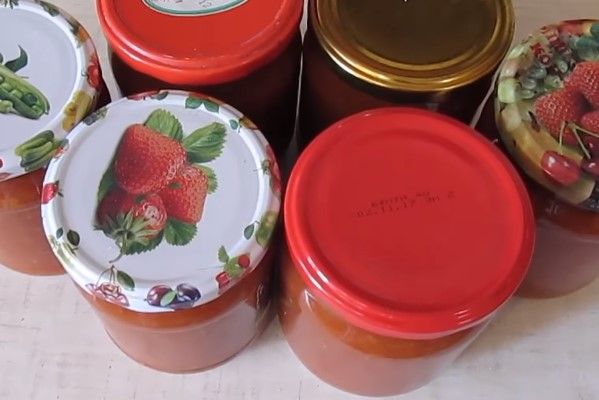

7. The next day, when it cools down, put it in a cool place, in a cellar or refrigerator. Optionally, you can rub it through a sieve to get a more homogeneous mass and resemble a store product.
Recipe for preserving tomatoes in their own juice
Cooking time: 55-65 minutes. Caloric content (per 100 g): 78-81 kcal. Preservation amount: for six liter cans. Kitchen utensils: several deep containers, kitchen scales and measuring utensils, a toothpick, six liter sterilized jars and iron lids, a juicer, a saucepan of at least 4 liters, a long wooden spoon, a cloth napkin, a large saucepan, a warm blanket, a lid rolling machine.
| small tomatoes | 3 Kg |
| large tomatoes | 2 Kg |
| salt | 45-50 g |
| granulated sugar | 25-30 g |
- Thoroughly wash 3 kg of small, firm, equally ripe tomatoes in warm water, then put them in a deep bowl. Put 2 kg of washed fleshy tomatoes of any size in a separate bowl. You will need them to make tomato juice.
- We pierce small fruits with a toothpick in several places. It is advisable to make about four holes - this will guarantee that the tomatoes will not crack when poured with very hot juice.
- We put the prepared tomatoes tightly in pre-washed and sterilized jars.
- Cut the meaty tomatoes into four pieces and pass them through a juicer. As a result, we get pure tomato juice.
- Pour the tomato juice into a saucepan and bring the liquid to a boil over medium to low heat.
- Add 45-50 g of salt and 25-30 g of sugar to the boiling liquid, mix everything well and reduce the heat to low.
- After boiling the juice for 10-15 minutes, taste it with salt, add a little more if necessary and bring it to a boil again.
- Fill cans of tomatoes with hot juice up to the very neck.
- We cover them with lids, which we pour over with boiling water in advance. Now we select a large saucepan, put a cloth napkin on the bottom and put the filled jars in it.
- Pour warm, almost hot water into a saucepan. In this case, the water level should be on the hanger of the container. Next, we wait for the water to boil, and thus sterilize the cans in water for about 8-10 minutes.
- After a while, we take out the cans from the pan and roll them up. We turn the glass container upside down, send it to a dark place, wrap it with a thick blanket.
- We leave the conservation in this form until it cools completely. Did you know? Delicate tomatoes in their own juice, prepared according to the above guide, are well stored both in the cellar and in any other suitable place.
Video recipe for preserving tomatoes in their own juice for the winter
The complete process of preserving tomatoes in their own juice according to the above recipe is shown in the video below.
Spicy Italian tomatoes in tomato paste
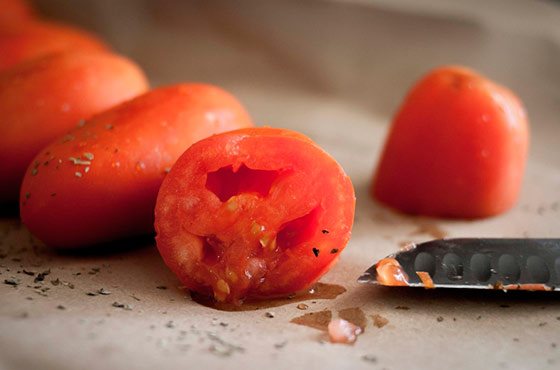

For this recipe, tomatoes should be the size of a nut or plum (you can also cherry), a dense consistency.It turns out very tasty and aromatic, you can use them for making pizza and pasta - such tomatoes are perfectly cut, as they become elastic and juicy.
Composition for 1 can of 1 l or 4 cans of 0.5 l:
- 1.6-2 kg of small tomatoes (about 0.8 kg goes for 1 can in 1 liter).
- 100 g thick tomato paste.
- 1 liter of water;
- 8 cloves of garlic;
- 4 cloves buds;
- 10 peas of black and allspice;
- a sprig of rosemary (or dried 0.5 tsp);
- 50 g of crystalline salt (2 tablespoons with top);
- 25 g sugar;
- 8 bay leaves;
- 50 ml olive oil;
- 1 tsp chopped fresh or dried dill.
Cooking:
Rinse the tomatoes, chop in 2-3 places. Fill jars with them.
Add all spices (except garlic), salt and sugar to 1 liter of water, bring to a boil.
Add tomato paste and cook mixture for 10 minutes, stirring occasionally.
Pour in olive oil, add crushed garlic and stir.
Pour the tomatoes with hot sauce, trying to put lavrushka, pepper and a little greens in each jar. Roll up immediately, cover tightly until it cools completely.
Recipe for green tomatoes in their own juice
Cooking time: 15-25 minutes. Caloric content (per 100 g): 76-79 kcal. Preservation amount: for one 3-liter jar. Kitchen utensils: one 3-liter jar, a kitchen long knife, a saucepan of at least 3 liters, a measuring cup, a nylon lid.
| horseradish leaf | 2-3 pcs. |
| cherry leaf | 2 pcs. |
| currant leaf | 2 pcs. |
| garlic | 8-10 teeth |
| dill | 2-3 umbrellas |
| green tomato | 15-20 pcs. |
| black peppercorns | 10-15 pcs. |
| water | 1.5 l |
| granulated sugar | 20-25 g |
| salt | 20-25 g |
| mustard | 20-25 ml |
- Put 2-3 dill umbrellas on the bottom of a clean and dry three-liter jar.
- Cut the cloves of garlic in the amount of 8-10 pieces in half so that the tomatoes are well marinated. Put half of the total amount of garlic on top of the dill.
- Add 2 leaves of horseradish, cherry and currant to the same place.
- Rinse green tomatoes in the amount of 15-20 pieces in warm water, then dry. Each fruit is slightly cut crosswise with a sharp knife so that the fruits are well marinated.
- We put the prepared tomatoes tightly in a glass container.
- On top of the fruits, lay out the remaining cloves of garlic, a horseradish leaf and 10-15 pieces of black peppercorns.
- Pour 1.5 liters of water into a saucepan, then add 20-25 g of sugar, 20-25 g of salt and 20-25 ml of mustard.
- Stir the cold marinade until all ingredients are completely dissolved in water.
- Fill the tamped tomatoes with the finished marinade to the very neck. We cover the jar with a nylon lid and send it to a cold, dark place.
Video recipe for preserving green tomatoes for the winter
The process of canning green tomatoes according to the above recipe is shown in the video below.
- Do not skimp on horseradish leaves, as they help maintain the density of tomatoes.
- For the preparation of brine, it is best to use mineral, spring or purified water. Never use tap water, as it will negatively affect the taste of the product.
Recommended canning recipes for the winter
I advise you to read the detailed information on how to cook pepper in tomato sauce for the winter. This is a very satisfying and healthy snack with a spicy flavor. Most modern housewives love to make zucchini in tomato sauce for the winter. The most aromatic dish will delight everyone who prefers healthy and tasty food.
Be sure to check out the best stuffed eggplant recipes for the winter. These dishes are a great option for a festive table. Lecho with rice for the winter can be eaten both cold and hot. This product goes well with any meat or even sausages, making lunch or dinner more nutritious.
That's all! Write your feedback on the preservation of tomatoes according to the above recipes, and also share your own experience in preparing such blanks! Good luck and bon appetit!
How much tomato paste is needed instead of 1 kg of tomatoes in lecho, other blanks?
Tomato pastes are different. There is one that is more like a sauce, another, like a village sour cream - a spoon is worth it. Of course, the second option is preferable. It needs to be boiled down less. Whatever it was, for lecho the solution of tomato paste should be boiled down almost twice. More precisely, up to 60 - 65 percent of the original volume.
Liquid contains a lot of water and dry matter in it from the strength of 15 - 20% This means that it will replace 1 kilogram of dense fleshy tomatoes in 3 - 5 times less. This will come out 300 - 400 grams of tomato paste. You can't calculate exactly. There are no identical tomatoes or pasta. But I stopped at the extremes.
In another version, the paste is thick in it dry matter 30 - and even 40%. It will need much less from 200 to 300 grams. But an experienced cook does not weigh in grams, does not use measuring cups and spoons. He does it by eye and taste.
Undoubtedly, sugar and salt are different. One is too salty, the other too sweet. If you give two housewives exactly the same products, they will come out differently. One will have a thick lecho, while the other will be like tomato juice. One prefers soft lecho, while the other likes almost fresh fruits.
Summary: they hang in grams, even if in advertising, and the cook uses pinches, grains and pours as much as, in his opinion, is correct. my choice tomato paste "Tomato"
According to this recipe, tomato paste for the winter is not only a natural source of vitamins, but also a convenient and healthy homemade preparation.
Without tomato paste, especially homemade ones, it is quite difficult to imagine cooking your favorite dishes in winter.
In the summer, after disposing of apples in the form of marshmallow or juice, the owners of summer cottages face another problem, only this time with tomatoes.
Despite the large number of already rolled jars of winter vegetable preparations, there are often quite a few tomatoes still left on the bushes.
In this case, an excellent solution to the tomato problem is harvesting tomatoes in the form of tomato paste, which can be stored in the house for more than one winter, of course, if vinegar was added to the tomato paste during cooking.
This recipe for tomato paste at home is calculated for simple and quick preparation, in such a simple way you can prepare large quantities of tomato paste for the winter by processing the entire remainder of fresh tomatoes into jars.
Advice from the Miracle Chef. In winter, canned tomato paste can be used not only as a dressing for soups and borscht, homemade tomato paste will be a delicious addition to gravy for pasta, cabbage rolls, spaghetti, goulash and many other dishes.
And most importantly, with the help of this recipe for tomato paste at home, you will stock up on natural harvesting from a large amount of boiled tomatoes in jars for the winter.
Preparation - 20 minutes
Cooking time - 15 minutes
Caloric content - 33 kcal per 100 grams
With Italian herbs
This recipe does not involve the use of pasta, but the output is about the same. Tomatoes are cooked in their own juice and Italian herbs give them a spicy flavor.
Since the recipe uses only tomato fruits and spices, there is no reference to proportions. Each housewife decides for herself how spicy the dish will be.
Put the tomatoes on a baking sheet. It is advisable to use large fruits of fleshy varieties. Sprinkle the tomatoes on top with a mixture of Italian herbs with salt and ground pepper. The baking sheet is placed in an oven preheated to 180 degrees. Usually the cooking time is 40 minutes. But if after half an hour the fruits begin to burst, remove the baking sheet from the oven. Next, the tomatoes are laid out in containers and canned.
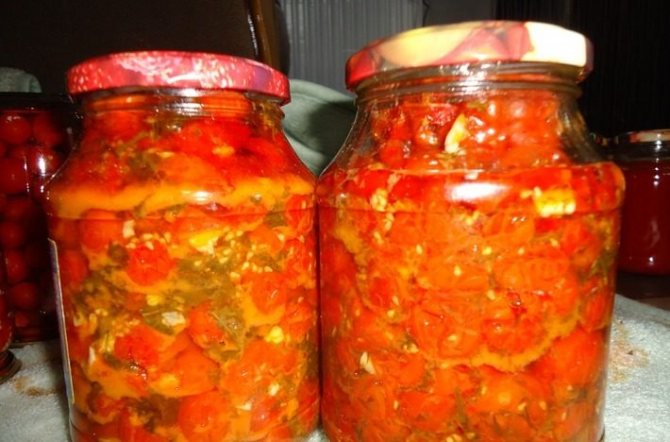

How to make tomato paste at home
- Remove the skin from the washed vegetables, for this we lower them one by one, first in boiling water for a few minutes, and then in cold water.
- After that, remove the skin from all the tomatoes.
- Then we cut them into pieces and transfer them to a large wide saucepan.
- Next, bring to a boil.
- Add the chopped onion immediately, mix.
- Reduce the heat to the lowest, cover the pan with a lid, only loosely. We boil the mass with frequent stirring so that it does not burn until it decreases in volume and thickens.
- Then cool the mixture slightly, grind it through a sieve or colander, discard the bones.
- Put the mashed potatoes in a clean saucepan, add granulated sugar, salt, bring to a boil again over medium heat.
- After the mixture boils for 5 minutes, pour in the vinegar, mix.
- We lay out the finished paste on pre-sterilized jars and roll up with metal lids.
Turn the curls with tomato paste upside down, wrap it in a warm blanket and leave it to cool completely, then store canned tomato paste in winter at home or take it to the cellar.
How to quickly make tomato paste from tomato through a blender
I also cook it through a blender. How is this device convenient? And the fact that he can quickly and thoroughly grind tomatoes along with other ingredients, thereby I save my time. If you don't have one, be sure to get such an irreplaceable assistant in the kitchen. Although, if you have a food processor, you can use it instead of a blender.
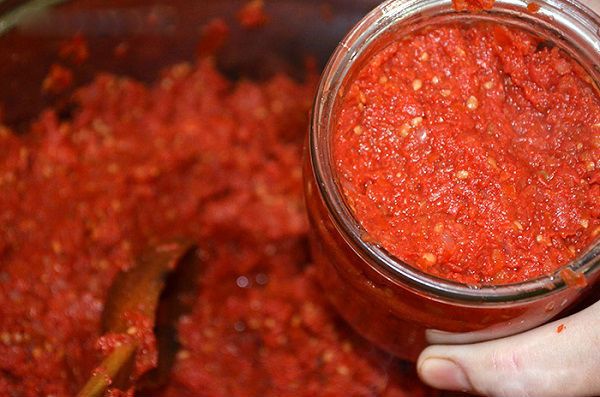

Ingredients:
- 9 kg. tomatoes;
- 800 gr. Luke;
- 100 g garlic;
- 750 gr. Sahara;
- 6 tbsp salt;
- 200 gr. vinegar (9%);
- 5 leaves of bay leaves;
- 1 tsp carnations;
- 1 tsp ground cinnamon.
Preparation:
1. Immerse the washed tomatoes in a saucepan of boiling water for 2 minutes. Next, take them out of the boiling water and fill them with cold water and leave for a few minutes. This makes it easier to remove the skin.
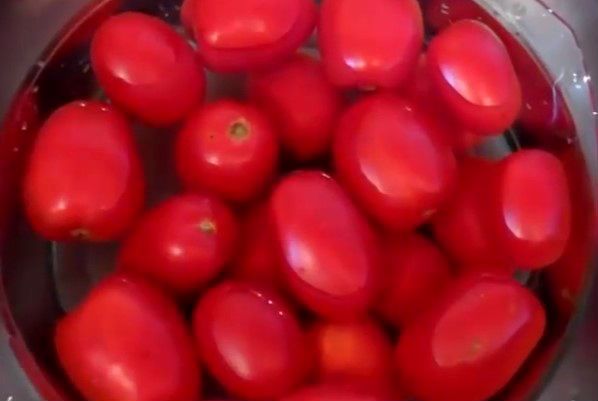

2. Now peel them off and cut into small pieces. Then put them in a peeled form in a blender. Add chopped onion and garlic there and chop.
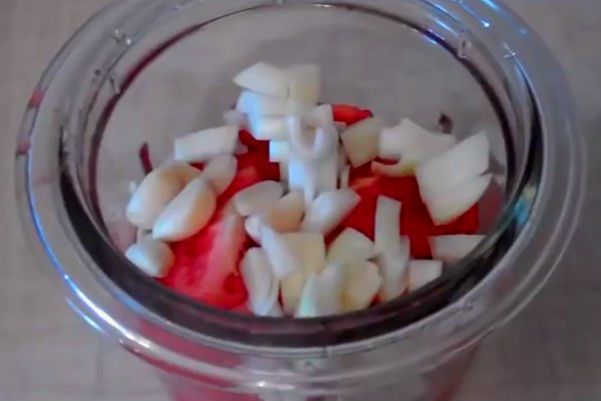

3. Here's what you should get.
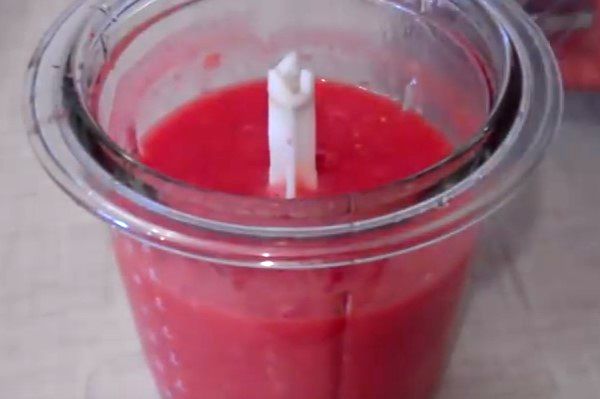

4. Then put this mass in a saucepan and place on the stove. When it boils, cook for another 45 minutes. Remember to stir constantly to prevent the pasta from burning.
5. After a while, add sugar, salt and mix well. Cook for another 45 minutes.
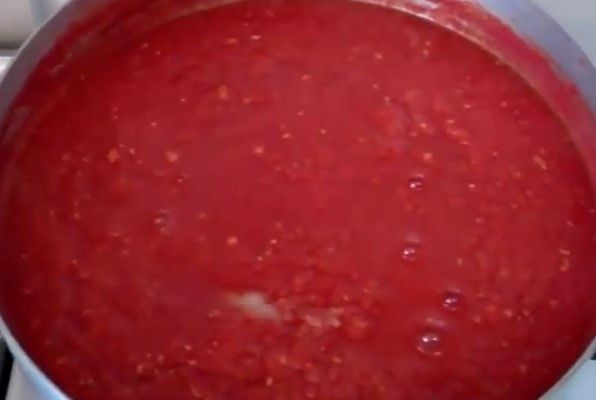

6. Next, take bay leaves, cloves, cinnamon and red pepper and wrap them in a small layer of cheesecloth, in a bag. Throw this bag into the brew and cook for another 1.5 hours. Then add 200 ml of vinegar and cook for 20 minutes.
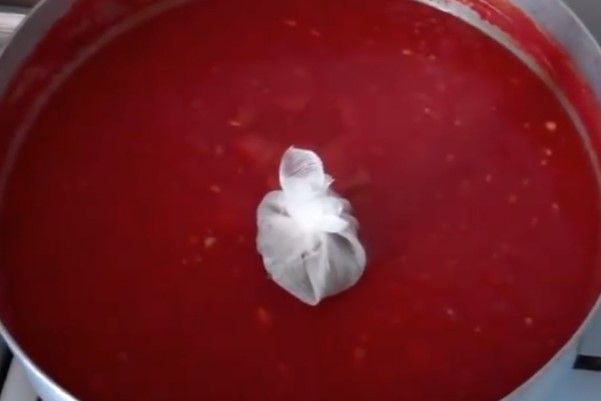

7. Now pour the composition into jars and roll up the lids.
Store the tomato paste with the lid down to extend its shelf life.
It will contain seeds and tomato pulp. If you want to get a more uniform structure, that is, as in a store, then you will have to grind it through a sieve.
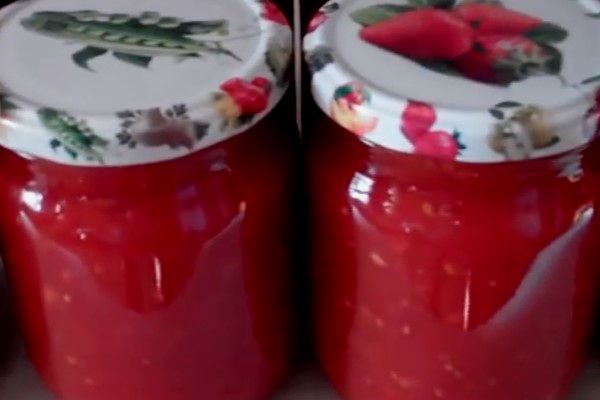

How to replace tomatoes with tomato paste in blanks
Some vegetables are beginning to ripen and you can already make preparations for the winter. But, for example, in squash caviar, lecho, some salads are required according to the recipe for tomatoes, but they have not yet ripened in sufficient quantities.
Author of the publication
Achievement received on 01/04/2019
Similar:
The question regarding tomato paste, in relation to tomatoes, can be considered in relation to the dishes, recipes that we are going to cook. For example, for cooking borscht, two tablespoons of tomato paste will replace a glass of juice. A glass of tomato juice is six medium fruits, 2 tablespoons of pasta. There is a certain ratio of a kilogram of tomatoes to the dry mass of tomato paste, about 1: 3, that is, one and a half kilograms of tomatoes will replace 0.5 kilograms of tomato paste. Having made the proportion, it is easy to calculate that tomato paste needs a little more than 0.3 kilograms instead of 1 kilogram of tomatoes in lecho, other homemade preparations.
Tomato pastes are different. There is one that is more like a sauce, another, like a village sour cream - a spoon is worth. Of course, the second option is preferable. It needs to be boiled down less.Whatever it was, for lecho the solution of tomato paste should be boiled down almost twice. More precisely, up to 60 - 65 percent of the original volume.
Liquid contains a lot of water and dry matter in it from the strength of 15 - 20% This means that it will replace 1 kilogram of dense fleshy tomatoes in 3 - 5 times less. This will come out 300 - 400 grams of tomato paste. It is impossible to calculate exactly. There are no identical tomatoes or pasta. But I stopped at the extremes.
In another version, the paste is thick in it dry matter 30 - and even 40%. It will need much less from 200 to 300 grams. But an experienced cook does not weigh in grams, does not use measuring cups and spoons. He does it by eye and taste.
Undoubtedly, sugar and salt are different. One is too salty, the other too sweet. If you give two housewives exactly the same products, they will come out differently. One will have a thick lecho, while the other will be like tomato juice. One prefers soft lecho, while the other likes almost fresh fruits.
Summary: they hang in grams, even if in advertising, and the cook uses pinches, grains and pours as much as, in his opinion, is correct. my choice tomato paste "Tomato"
Ketchup? Tomato paste? What's better? How much pasta or sauce do you need if the recipe contains 1.5 kg of tomatoes?
For preparations for the winter, you can make different vegetables (eggplant, zucchini, cucumbers) in tomato sauce made from diluted tomato paste (ketchup, tomato puree) or you can put fresh tomatoes (tomato juice from tomatoes).
You can take either tomato juice (ground fresh tomatoes) or tomato paste, or you can add tomato juice and paste in half.
You can navigate about the mass of tomato paste in relation to tomatoes in different ways.
If in borscht we put one or two tablespoons of tomato paste instead of a glass of tomato juice on a glass of boiling water, then in the blanks, too, for each glass (200 ml) of whole tomato juice, you can use one or two full tablespoons with a slide of tomato paste.
One glass of tomato juice contains 5 - 6 ripe tomatoes.
That is, one to two tablespoons of tomato paste is equal to a glass of tomato juice, equal to about five to six medium tomatoes.
Moreover, it is good to add tomato paste so that it can not be diluted with water to the state of tomato juice, but added directly from the bag with a thick tomato mass, so the dish will be thicker - instead of a glass of tomato, only dry mass from tomato paste.
Usually I combine - and tomatoes, and tomato paste, I do "by eye". I look at how much tomato is needed for a given amount of zucchini / eggplant or how much tomato is needed, chopped, chopped into pieces, tomato puree, and in addition, for the density and saturation of color and taste, you can add tomato paste.
I also found information that with a ratio of a kilogram of tomato and dry mass of tomato paste, the ratio is about 1: 3, that is
If the recipe contains one and a half kilograms of tomato, then this is equal to half a kilogram of tomato paste. This is approximately, but you can put more or less, focusing on taste. Or you can put half with fresh tomatoes (tomato juice from fresh tomatoes) and half with tomato paste.
Among the canned vegetables, which are harvested for the winter, tomatoes marinated in tomato paste, juice, marinade and other fillings are popular. Thanks to the use of a variety of seasonings and spices, tomatoes with unusual and different flavors are obtained. The correct choice of vegetables and additional products is of great importance for obtaining high-quality and tasty preservation.
> Selecting and preparing tomatoes
Fresh, firm, medium-sized fruits are selected for harvesting. To prepare the sauce, tomatoes of any size and shape are suitable, the main thing is without rot and spoilage.
> How to prepare a container?
After thorough washing, glass containers are sterilized in the usual way. You can fry in the oven, steam over boiling water, use the microwave.
Canned tomatoes can be stored in a cool, dark room, pantry, on the bottom shelf of your refrigerator, or in your basement. Preservation should not be in a bright room, where direct sunlight penetrates.
The shelf life of a vegetable preparation at room temperature is no more than twelve months. Tomatoes, which are at a temperature of no higher than five degrees, are stored for three years.
Tomatoes in tomato sauce with mustard
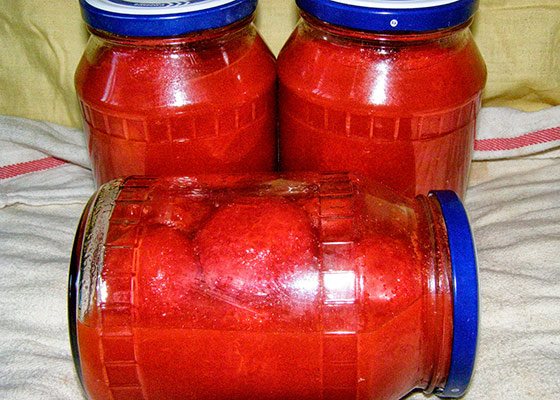

Salad version in tomato sauce, flies off the table with a bang. The mustard sauce is so delicious that you can simply spread it on bread, add it to borscht, to meat, and use tomatoes to make winter salads.
What do you need:
Ripe small tomatoes of dense varieties.
For tomato sauce:
- 2 kg of very ripe large juicy tomatoes.
- 3 large onions.
- 1 tbsp no top of mustard powder.
- 50 g of sugar.
- 30 g of salt.
- 100 g of vegetable oil.
- Half a bunch of parsley.
- 5-6 bay leaves.
Preparation:
First, we eat cans of 0.5-1 liters. Be sure to dry them in the oven.
Wash small tomatoes and let them air dry.
Then we make the sauce: we cut large tomatoes at random, onions - into small cubes and fry in vegetable oil for several minutes, then add 7 tbsp. hot water, all spices, mustard powder and cook for 1 hour until thickened. Constantly interfere. You can put everything in a multicooker for 45 minutes, then this procedure will disappear. The sauce is ready - you do not need to separate the seeds and skins (although you can - if you wish).
Fill the jars with hot pouring and put them in a heated oven without lids for 10 minutes, then roll up.

